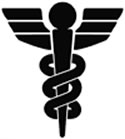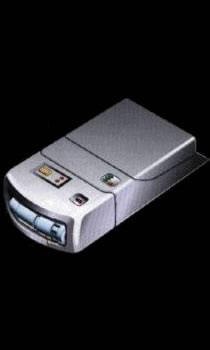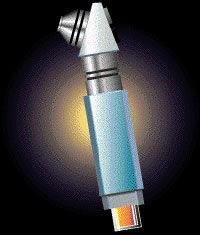 |
 Welcome to the medical database. Here you will find information on the various pieces of medical equipment the Federation carries. Each entry contains a brief summary of what the equipment is used for. Welcome to the medical database. Here you will find information on the various pieces of medical equipment the Federation carries. Each entry contains a brief summary of what the equipment is used for.
Medical Tricorder
 The Medical Tricorder is modified with an extra external medical probe and scanner attachment. It has the following capabilities: The Medical Tricorder is modified with an extra external medical probe and scanner attachment. It has the following capabilities:
*Biosanpler
*Bioscanner
*Chemscanner
*Datalink
*Environmental Analysis
*Medscanner
*Multiscanner
*Radscanner
For its size, the medical tricorder can maintain and store vast amounts of data in its own memory. It contains over 100 sensors, and also has a specialized medical database that provides detailed medical diagnostic tools in the field including tomographic and micrographic imaging.
Hypospray
 A hand-held device used for subcutaneous and intravenous administration of carefully controlled dosages of medications. The hypospray injects a subject by using a pinpoint, high pressure, low-volume, microscopic, aerosuspension stream. It allows medication to be given though the skin or clothing without mechanical penetration. The hypospray can also be fitted with an adaptor that allows it to work with IV lines. A hand-held device used for subcutaneous and intravenous administration of carefully controlled dosages of medications. The hypospray injects a subject by using a pinpoint, high pressure, low-volume, microscopic, aerosuspension stream. It allows medication to be given though the skin or clothing without mechanical penetration. The hypospray can also be fitted with an adaptor that allows it to work with IV lines.
Trilaser Connector:
Also known as synaptic braider; it is used to repair and reconnect damaged nerves.
Vitalizer Beam:
A field which can be placed around an individual to prevent the loss of blood. Vitalizer beams come in a variety of sizes, although it should be noted that even a vitalizer beam will not be able to prevent a deadly hemorrhage and should be used as a stop gap measure until the cause of the hemorrhage is repaired.
Alpha Wave Inducer:
This device is used to induce sleep in most humanoids. It is not meant to replace natural sleep and cannot be used frequently. It is an electronic version of an anesthestic. In conjuction with medications, the subject enters a deep dreamless sleep during which surgical procedures can be carried out without causing pain.
Anabolic Protoplasers:
These devices are used to heal internal and external damage to the body without having to open up the patient to effect repairs (although sometimes it is still necessary to perform an open body cavity surgery.) They CANNOT replace surgery in serious injuries, and it can not repair incidental damage resulting from the original injury.
Bone Knitters:
These devices are used to help heal and repair broken bones. They come in a variety of shapes and sizes for the different sizes of bones in most humanoid bodies.
Cardiostimulator:
The new age defibrillator, this works just like the defibrillators of today except it will not damage surface tissues, although there is still damage to the cellular structures of the myocardial tissue. The cardiostimulator is capable of defibrillation, pacing, and cardioversion.
Dermoplastic Graphs:
These help in the regeneration of tissue when placed in direct contact with the patient's body. Graphs come in a variety of shapes and size and are capable of healing tissue all the way down to the layer of tissue directly above muscle tissue. This device is incapable of healing bones and muscle tissue.
Neural Analyzer:
Used to monitor and analyze the actions of a patients CNS.
Neural Stimulator:
This device attempts to “jumpstart” the CNS of patients who have suffered some sort of neuo-synaptic failure.
Field Medical Kit:
This kit is carried by medical personal such as paramedics, nurses, and Marine Medics.
1-Dermal regenerator
2-Bandage assortment
1-Cardiostimulator
1-Medical Tricorder
2-Hyposprays
1-1000ml bags of Hemopak
2-500ml bags of Hemopak
1-Respirator (includes automated and manual BVM and other airway adjunctants.)
1-Sampling kit
The kit contains the following medications:
5 vials of Hyronaline
3 vials of Stenophyl
2 vials of Pulomazine
1 vial of Vasopressin
3 vials of Epinephrine
4 vials of Metrazine
4 vials of Inaprovaline
4 vials of Amyltriptoline
Medical kits can be tailored to specific missions but this must be done before heading out on the away mission.
|









|



